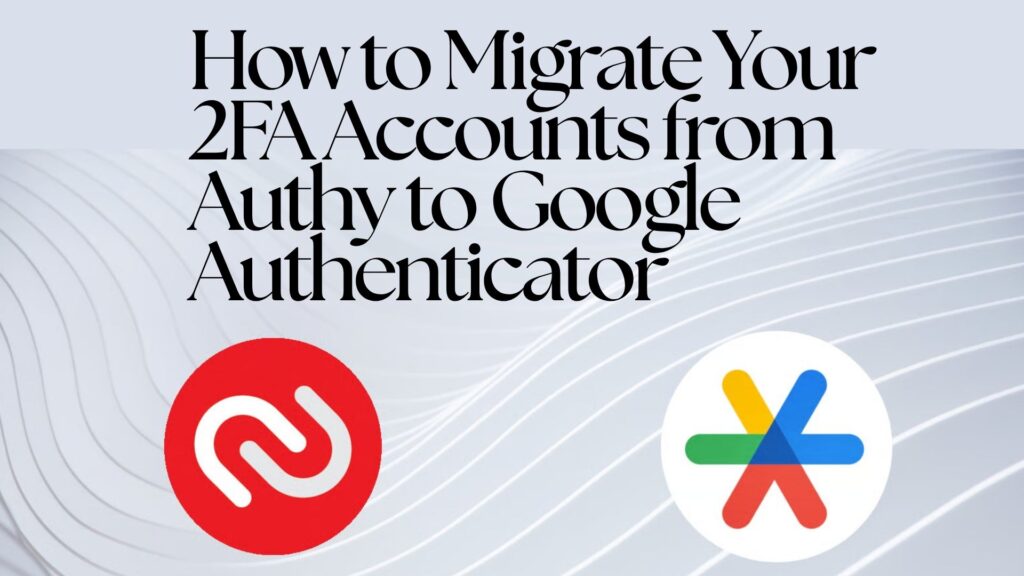Migrating from Authy to Google Authenticator? Two-factor authentication (2FA) is a crucial layer of protection for your online accounts, but switching authenticator apps can be necessary in certain situations. If you’ve been using Authy and want to switch to Google Authenticator, you’ll need to manually transfer your accounts because the two apps store 2FA keys differently. This guide will walk you through the process step by step.
Why Migrate from Authy to Google Authenticator?
There are several reasons why users might consider switching from Authy to Google Authenticator:
1. Preference for Simplicity
While Authy offers advanced features like cloud backup and multi-device sync, some users prefer the simpler, more minimalistic approach of Google Authenticator. Google Authenticator is easy to set up and doesn’t require registration or account syncing.
2. Security Concerns
In a recent cybersecurity incident, Twilio, the developer of Authy, confirmed a breach that exposed millions of users’ phone numbers. The attack exploited an “unauthenticated endpoint” in Twilio’s system, potentially affecting up to 33 million phone numbers. Though no other sensitive data was compromised, the incident underscored the risks associated with centralized services like Authy. Twilio quickly patched the vulnerability, but the hack has raised concerns among users regarding the safety of their authentication methods.
This breach has led many users to reconsider their 2FA app, preferring a more decentralized solution like Google Authenticator, which stores your keys only on your local device.
Step-by-Step Guide to Migrate Your 2FA from Authy to Google Authenticator
Step 1: Access Your Accounts in Authy
- Open the Authy app on your phone or desktop.
- Select the account you wish to migrate. You should see the 2FA code and account details for this service.
- Leave Authy open as you’ll need it for reference in later steps.
Step 2: Disable 2FA on Your Online Account
Next, you’ll need to disable 2FA for the account you want to transfer:
- Log in to the online service where you currently use Authy (e.g., Gmail, GitHub, etc.).
- Go to the security settings section of the account.
- Find the option to disable two-factor authentication. You will likely need to enter your Authy-generated 2FA code to confirm this step.Tip: Always ensure you’ve saved any backup codes provided by the service before disabling 2FA, just in case you run into issues.
Step 3: Re-enable 2FA with Google Authenticator
Now that 2FA is disabled for that account, you can set it up again using Google Authenticator:
- In your account’s security settings, look for the option to enable two-factor authentication.
- You’ll be presented with a QR code. Open the Google Authenticator app on your smartphone and tap the “+” button to add a new account.
- Use the app to scan the QR code (or manually enter the key if provided by the site).
- Once the account is added to Google Authenticator, the app will generate a new 2FA code.
- Enter this code back into the website to confirm that the setup is successful.
Step 4: Repeat for Each Account
Unfortunately, there’s no bulk export/import tool, so you’ll need to repeat these steps for each account that uses 2FA with Authy. It may take some time, but it’s necessary to ensure your 2FA codes are correctly transferred.
Why Google Authenticator?
Google Authenticator is widely used due to its simplicity, offline functionality, and lack of centralized storage. Unlike Authy, it does not sync across devices, which can be seen as both a strength (increased privacy) and a limitation (manual backups are required). Additionally, Google Authenticator does not require users to register or sign in, minimizing the risk of centralized breaches like the one experienced by Authy.
Important Considerations
- Backup Codes: Make sure to save backup codes from each account during the migration process. These will help you regain access if you lose your device.
- Syncing Between Devices: Unlike Authy, Google Authenticator does not automatically sync across devices. If you change phones or use multiple devices, you’ll need to manually transfer the 2FA codes to the new device. Google Authenticator has recently introduced cloud sync in some versions, but this feature might not be available on all devices.
- Security: Keep Authy installed on your device until you have confirmed that all accounts are successfully set up in Google Authenticator.
Conclusion
Migrating your 2FA accounts from Authy to Google Authenticator is a manual process, but it’s worthwhile if you prefer the simplicity and decentralization of Google’s app. Whether you’re concerned about security following the Twilio hack, or you simply want a more minimal solution, following these steps will help you make the transition smoothly.
Remember to stay vigilant with your backup codes and take precautions to ensure you don’t lose access to your accounts during the migration.
If you have any questions or run into any issues, feel free to leave a comment below!
